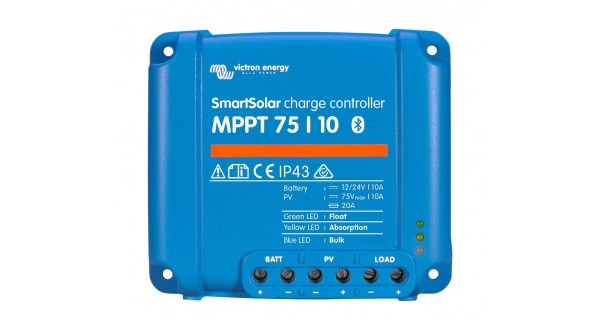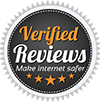More info

SmartSolar is all about functionality and options. These highly efficient ultra-fast Maximum Power Point Tracking (MPPT) solar charge controllers have it all - from high efficiency, optimal partial shading performance, programmable battery algorithms, street light functions and more. Smart is for built in Bluetooth for monitoring and control with VictronConnect. Options include remote monitoring over the internet via the VRM Portal, also a pluggable LCD display for the larger models.
Bluetooth Smart built-in: dongle not needed
The wireless solution to set-up, monitor and update the controller using Apple and Android smartphones, tablets or other devices.
VE.Direct
For a wired data connection to a Color Control panel, PC or other devices
Ultra fast MPPT tracking
Especially in case of a clouded sky, when light intensity is changing continuously, a fast MPPT algorithm will improve energy harvest by up to 30% compared to PWM charge controllers and by up to 10% compared to slower MPPT controllers.
Load output
Over-discharge of the battery can be prevented by connecting all loads to the load output. The load output will disconnect the load when the battery has been discharged to a pre-set voltage. Alternatively, an intelligent battery management algorithm can be chosen: Battery
Life. The load output is short circuit proof. Some loads with high inrush current can best be connected directly to the battery. If equipped with a remote on-off input, these loads can be controlled by connecting the load output of the controller this remote on-off input. Alternatively, a BatteryProtect may be used to control the load. Please see our website for specifications.
Battery Life: intelligent battery management
When a solar charge controller is not able to recharge the battery to its full capacity within one day, the result is often that the battery will continually be cycled between a ‘partially charged’ state and the ‘end of discharge’ state. This mode of operation (no regular full recharge) will destroy a lead-acid battery within weeks or months. The Battery Life algorithm will monitor the state of charge of the battery and, if needed, day by day slightly increase the load disconnect level (i.e. disconnect the load earlier) until the harvested solar energy is sufficient to recharge the battery to nearly the full 100%. From that point onwards the load disconnect level will be modulated so that a nearly 100% recharge is achieved about once every week.
Internal temperature sensor
Compensates absorption and float charge voltages for temperature.
Automatic battery voltage recognition
The controller will automatically adjust itself to a 12V or a 24V system one time only. If a different system voltage is required at a later stage, it must be changed manually, for example with the Bluetooth app.
Three step charging
The controller is configured for a three step charging process: Bulk – Absorption - Float.
Bulk
During this stage the controller delivers as much charge current as possible to rapidly recharge the batteries.
Absorption
When the battery voltage reaches the absorption voltage, the controller switches to constant voltage mode. When only shallow discharges occur, the absorption time is kept short in order to prevent overcharging of the battery. After a deep discharge the absorption time is automatically increased to make sure that the battery is completely recharged. Additionally, the absorption period is also ended when the charge current decreases to less than 1A.
Float
During this stage, float voltage is applied to the battery to maintain a fully charged state. When the battery voltage drops below float voltage during at least 1 minute a new charge cycle will be triggered.
Configuring and monitoring
- Bluetooth Smart (built-in): connect to a smartphone or tablet running iOS or Android.
- Use the VE.Direct to USB cable (ASS030530000) to connect to a PC, a smartphone with Android and USB On-The-Go support (requires additional USB OTG cable).
- Use a VE.Direct to VE.Direct cable to connect to a MPPT Control or a Color Control panel.
| SmartSolar charge controller | MPPT 75/10 | MPPT 75/15 | MPPT 100/15 | MPPT 100/20 |
| Battery voltage | 12/24V Auto Select | |||
| Maximum battery current | 10 A | 15 A | 15 A | 20 A |
| Nominal PV power, 12V 1a,b) | 145 W | 220 W | 220W | 290W |
| Nominal PV power, 24V 1a,b) | 290 W | 440 W | 440W | 580W |
| Max. PV short circuit current 2) | 13 A | 15 A | 15A | 20A |
| Automatic load disconnect | Yes, maximum load 15A | Yes, maximum load 20 A | ||
| Maximum PV open circuit voltage | 75 V | 100V | 100V | |
| Peak efficiency | 98 % | |||
| Self consumption | 10 mA | |||
| Charge voltage 'absorption' | 14,4V / 28,8V (adjustable) | |||
| Charge voltage 'equalization' | 16,2 V/32,4 V (adjustable) | |||
| Charge voltage 'float' | 13,8 V/27,6 V (adjustable) | |||
| Charge algorithm | multi-stage adaptive or user defined algrithm | |||
| Temperature compensation | -16 mV / °C resp. -32 mV / °C | |||
| Continuous load current | 15 A | 20 A | ||
| Low voltage load disconnect | 11,1 V / 22,2 V ou 11,8V / 23,6V or Algorithme BatteryLife | |||
| Low voltage load reconnect | 13,1 V / 26,2 V ou 14 V / 28 V or Algorithme BatteryLife | |||
| Protection | Battery reverse polarity (fuse) Output short circuit / Over temperature | |||
| Operating temperature | -30 to +60°C (full rated output up to 40°C) | |||
| Humidity | 100%, non-condensing | |||
| Maximum altitude | 5000m (full rated output up to 2000m) | |||
| Environmental condition | Indoor type 1, unconditioned | |||
| Pollution degree | PD3 | |||
| Data communication | VE.Direct port or Bluetooth | |||
| ENCLOSURE | ||||
| Colour | Bleu (RAL 5012) | |||
| Power terminals | 6 mm² / AWG10 | |||
| Protection category | IP43 (electronic components) IP22 (connection area) | |||
| Weight | 0,5 kg | 0,6 kg | 0,65 kg | |
| Dimensions (h x w x d) | 100 x 113 x 40 mm | 100 x 113 x 50 mm | 100 x 113 x 60 mm | |
| STANDARDS | ||||
| Safety | EN/IEC 62109-1 | |||
| 1a) If more PV power is connected, the controller will limit input power 1b) The PV voltage must exceed Vbat + 5V for the controller to start. Thereafter the minimum PV voltage is Vbat + 1V. 2) A higher short circuit current may damage the controller in case of reverse polarity connection of the PV array. | ||||
Data sheets and documentation
- Number of Reviews : 1
- Average Grade : 5 /5
- A. Anonymous
- the 09/06/2021
 5/5
5/5
Specifications
| 10A | |
| 20A | |
| 15A |


























